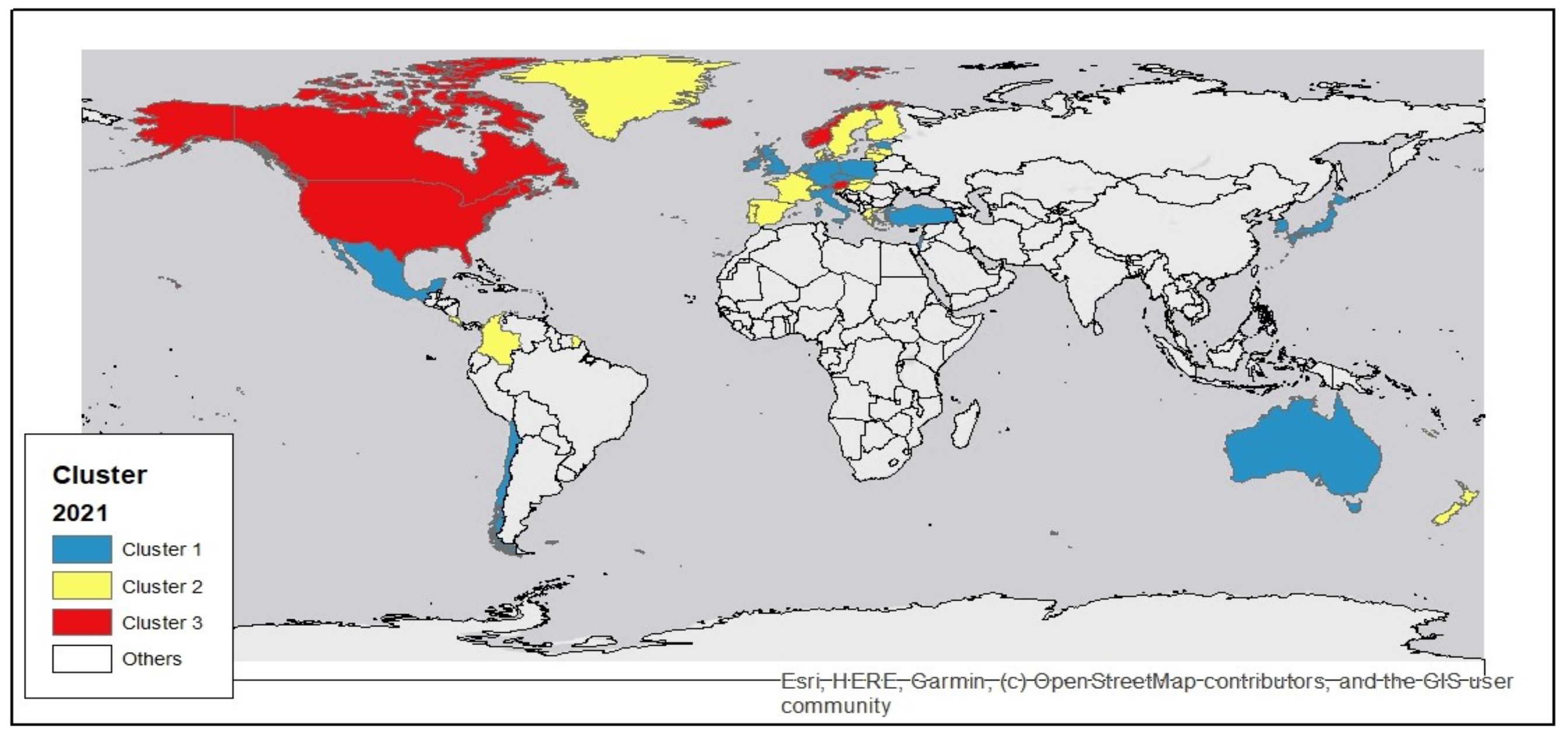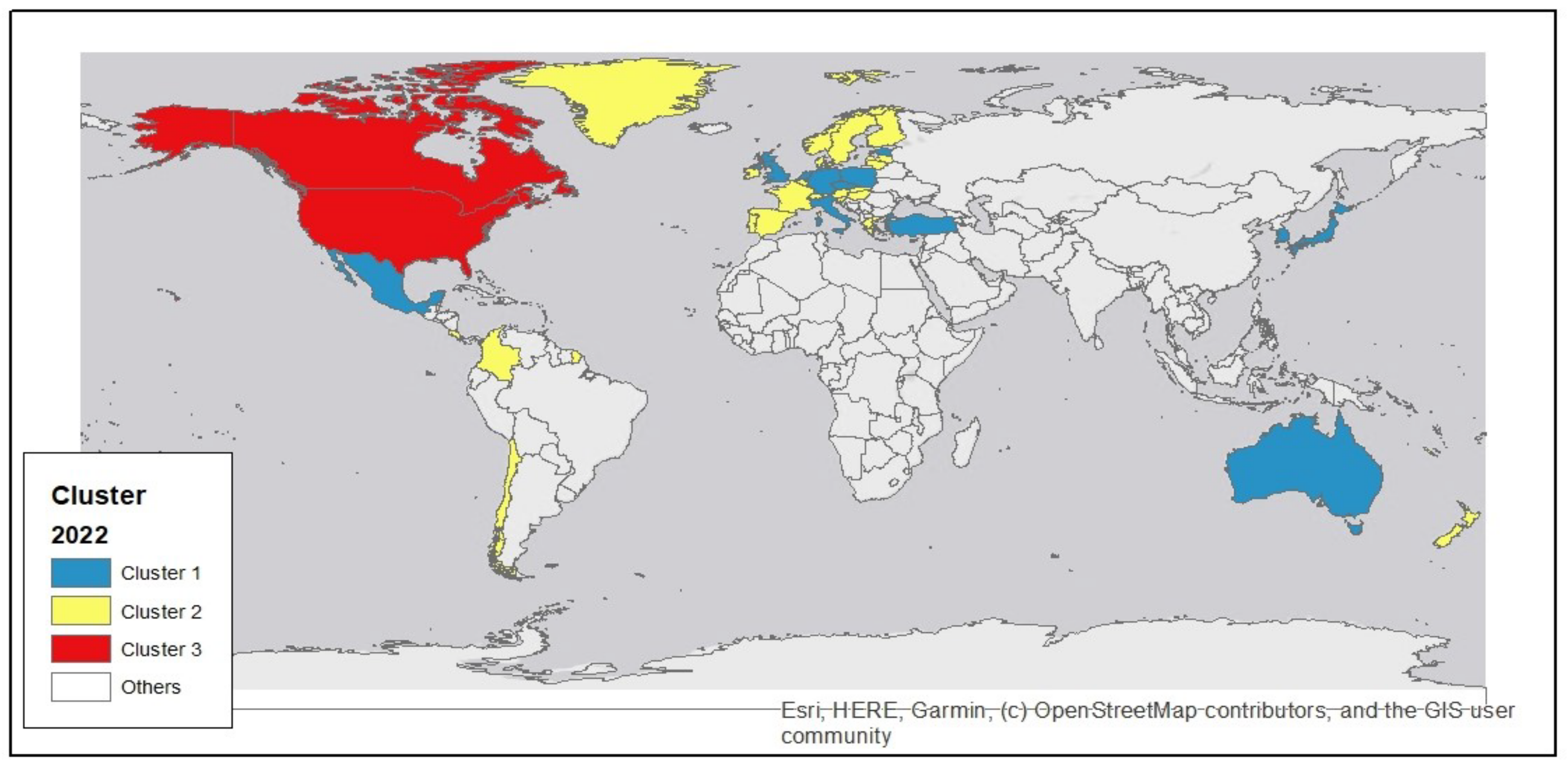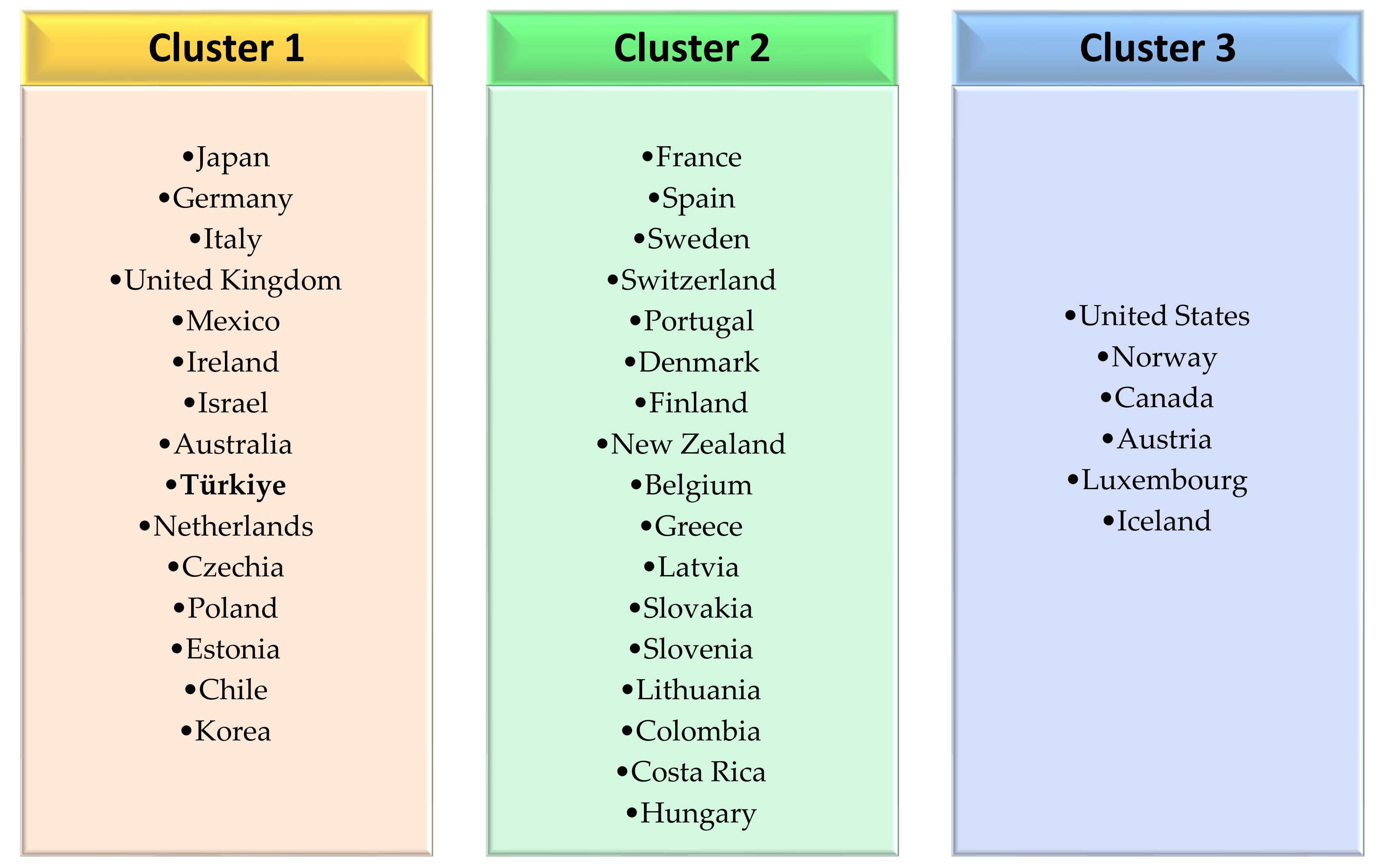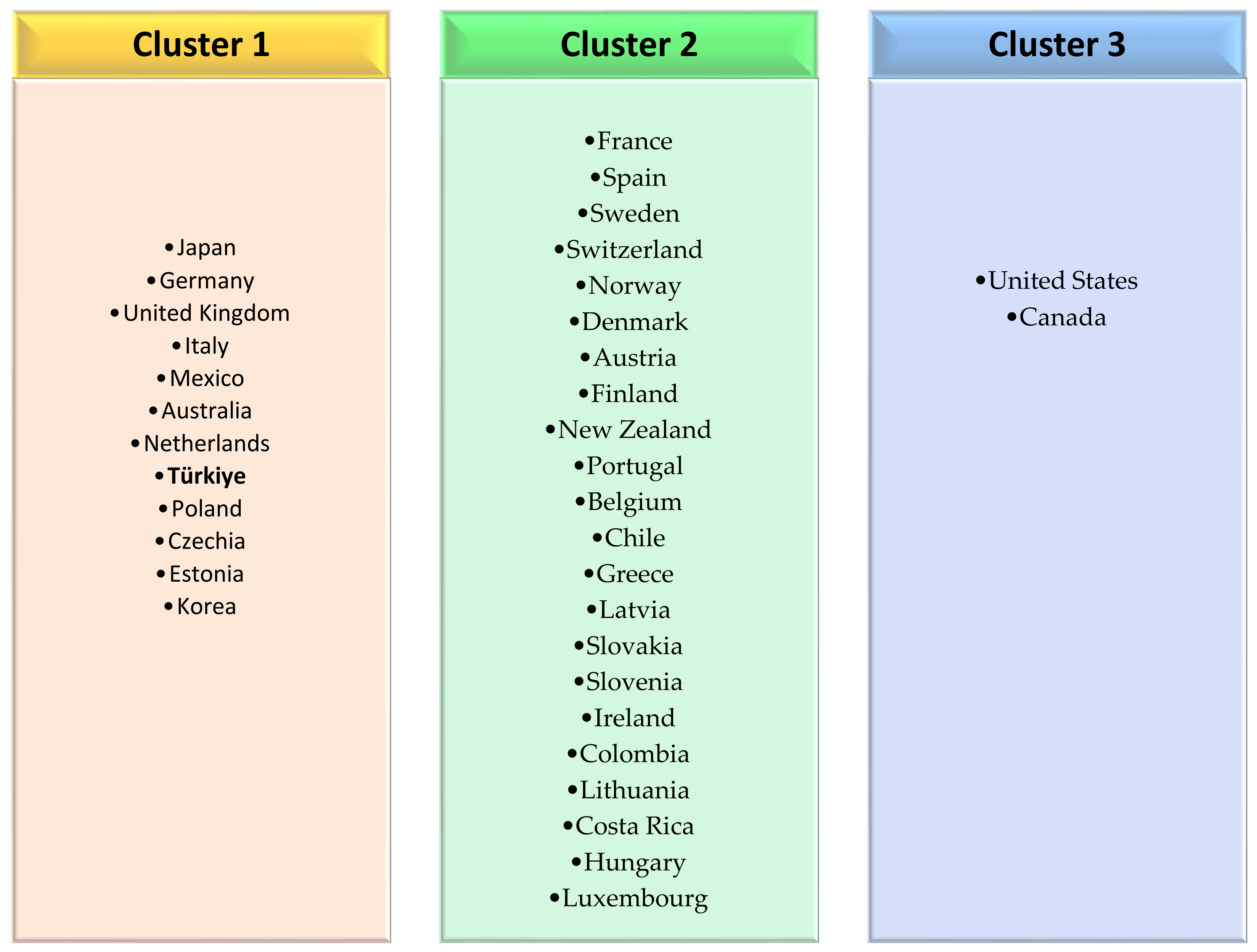Determination of Renewable Energy Growth Using Cluster Analysis and Multi-Criteria Decision-Making Methods
Abstract
1. Introduction
2. Materials and Methods
2.1. Cluster Analysis
2.2. MCDM Methods
2.2.1. CRITIC Method
- Step 1: Creating the Decision Matrix
- Step 2: Normalization of Decision Matrix
- Step 3: Creating the Relationship Coefficient Matrix
- Step 4: Calculating Values
- Step 5: Calculation of Criteria Weights
2.2.2. COPRAS Method
- Step 1: Creating the Decision Matrix
- Step 2: Normalization of the Decision-Making Matrix
- Step 3: Determination of the Weighted Normalized Decision-Making Matrix
- Step 4. Calculation of Maximization and Minimization Index for Each Alternative
- Step 5. Calculating the relative weight of each alternative
- Step 6. Prioritizing the alternatives
- Step 7. Calculating the Performance Index () Value for Each Alternative
3. Results
3.1. Cluster Analysis with K-Means Algorithm
3.2. Weighting with the CRITIC Method
3.3. Ranking with COPRAS Method
4. Conclusions
Author Contributions
Funding
Institutional Review Board Statement
Informed Consent Statement
Data Availability Statement
Conflicts of Interest
References
- Brodny, J.; Tutak, M. Assessing the energy security of European Union countries from two perspectives—A new integrated approach based on MCDM methods. Appl. Energy 2023, 347, 121443. [Google Scholar] [CrossRef]
- Almutairi, K.; Hosseini Dehshiri, S.J.; Hosseini Dehshiri, S.S.; Mostafaeipour, A.; Hoa, A.X.; Techato, K. Determination of optimal renewable energy growth strategies using SWOT analysis, hybrid MCDM methods, and game theory: A case study. Int. J. Energy Res. 2022, 46, 6766–6789. [Google Scholar] [CrossRef]
- Çolak, M.; Kaya, İ. Prioritization of renewable energy alternatives by using an integrated fuzzy MCDM model: A real case application for Turkey. Renew. Sustain. Energy Rev. 2017, 80, 840–853. [Google Scholar] [CrossRef]
- Aytekin, A. Energy, environment, and sustainability: A multi-criteria evaluation of countries. Strateg. Plan. Energy Environ. 2022, 41, 281–316. [Google Scholar] [CrossRef]
- Büyüközkan, G.; Karabulut, Y.; Mukul, E. A novel renewable energy selection model for United Nations’ sustainable development goals. Energy 2018, 165, 290–302. [Google Scholar] [CrossRef]
- Faraji Abdolmaleki, S.; Esfandiary Abdolmaleki, D.; Bello Bugallo, P.M. Finding sustainable countries in renewable energy sector: A case study for an EU energy system. Sustainability 2023, 15, 10084. [Google Scholar] [CrossRef]
- Ishfaq, S.; Ali, S.; Ali, Y. Selection of optimum renewable energy source for energy sector in Pakistan by using MCDM approach. Process Integr. Optim. Sustain. 2018, 2, 61–71. [Google Scholar] [CrossRef]
- Kabak, M.; Daǧdeviren, M. Prioritization of renewable energy sources for Turkey by using a hybrid MCDM methodology. Energy Convers. Manag. 2014, 79, 25–33. [Google Scholar] [CrossRef]
- Lee, H.C.; Chang, C.T. Comparative analysis of MCDM methods for ranking renewable energy sources in Taiwan. Renew. Sustain. Energy Rev. 2018, 92, 883–896. [Google Scholar] [CrossRef]
- Li, T.; Li, A.; Guo, X. The sustainable development-oriented development and utilization of renewable energy industry—A comprehensive analysis of MCDM methods. Energy 2020, 212, 118694. [Google Scholar] [CrossRef]
- Ecer, F.; Pamucar, D.; Hashemkhani Zolfani, S.; Keshavarz Eshkalag, M. Sustainability assessment of OPEC countries: Application of a multiple attribute decision making tool. J. Clean. Prod. 2019, 241, 118324. [Google Scholar] [CrossRef]
- Atmaca, E.; Basar, H.B. Evaluation of power plants in Turkey using analytic network process (ANP). Energy 2012, 44, 555–563. [Google Scholar] [CrossRef]
- Ishizaka, A.; Siraj, S.; Nemery, P. Which energy mix for the UK (United Kingdom)? An evolutive descriptive mapping with the integrated GAIA (graphical analysis for interactive aid)-AHP (analytic hierarchy process) visualization tool. Energy 2016, 95, 602–611. [Google Scholar] [CrossRef]
- Streimikiene, D.; Balezentis, T.; Krisciukaitien, I.; Balezentis, A. Prioritizing sustainable electricity production technologies: MCDM approach. Renew. Sustain. Energy Rev. 2012, 16, 3302–3311. [Google Scholar] [CrossRef]
- Ertay, T.; Kahraman, C.; Kaya, I. Evaluation of renewable energy alternatives using MACBETH and fuzzy AHP multicriteria methods: The case of Turkey. Technol. Econ. Dev. Econ. 2013, 19, 38–62. [Google Scholar] [CrossRef]
- Kaya, T.; Kahraman, C. Multicriteria renewable energy planning using an integrated fuzzy VIKOR & AHP methodology: The case of Istanbul. Energy 2010, 35, 2517–2527. [Google Scholar] [CrossRef]
- Chomać-Pierzecka, E.; Sobczak, A.; Sobo’n, D. The Potential and Development of the Geothermal Energy Market in Poland and the Baltic States—Selected Aspects. Energies 2022, 15, 4142. [Google Scholar] [CrossRef]
- Menegaki, A.N.; Tiwari, A.K. The index of sustainable economic welfare in the energy-growthnexus for American countries. Ecol. Indic. 2017, 72, 494–509. [Google Scholar]
- Pestana, D.G.; Rodrigues, S.; Morgado-Dias, F. Environmental and economic analysis of solar systems in Madeira, Portugal. Util. Policy 2018, 55, 31–40. [Google Scholar]
- Ślusarczyk, B.; Żegleń, P.; Kluczek, A.; Nizioł, A.; Górka, M. The Impact of Renewable Energy Sources on the Economic Growth of Poland and Sweden Considering COVID-19 Times. Energies 2022, 15, 332. [Google Scholar] [CrossRef]
- Amri, F. Intercourse across economic growth, trade and renewable energy consumption in developing and developed countries. Renew. Sustain. Energy Rev. 2017, 69, 527–534. [Google Scholar]
- Andrei, J.V.; Mieila, M.; Panait, M. The impact and determinants of the energy paradigm on economic growth in European Union. PLoS ONE 2017, 12, e0173282. [Google Scholar] [CrossRef]
- Jebli, M.B.; Youssef, S.B. The environmental Kuznets curve, economic growth, renewable and non-renewable energy, and trade in Tunisia. Renew. Sustain. Energy Rev. 2015, 47, 173–185. [Google Scholar]
- Lund, B.; Ma, J. A review of cluster analysis techniques and their uses in library and information science research: K-means and k-medoids clustering. Perform. Meas. Metr. 2021, 22, 161–173. [Google Scholar] [CrossRef]
- Al-Wakeel, A.; Wu, J. K-means based cluster analysis of residential smart meter measurements. Energy Procedia 2016, 88, 754–760. [Google Scholar] [CrossRef]
- Diakoulaki, D.; Mavrotas, G.; Papayannakis, L. Determining objective weights in multiple criteria problems: The critic method. Comput. Ops. Res. 1995, 22, 763–770. [Google Scholar]
- Ayçin, E. Personel seçim sürecinde CRITIC ve MAIRCA yöntemlerinin kullanılması. Bus. J. 2020, 1, 1–12. [Google Scholar]
- Pamucar, D.; Žižović, M.; Đuričić, D. Modification of the critic method using fuzzy rough numbers. Decis. Mak. Appl. Manag. Eng. 2022, 5, 362–371. [Google Scholar] [CrossRef]
- Organ, A.; Engin Yalçın, A.; Ass, R. Performance evaluation of research assistants by Copras method. Eur. Sci. J. 2016, 12, 102–109. [Google Scholar]
- Venkata Ramana, K.N.S.; Krishankumar, R.; Trzin, M.S.; Amritha, P.P.; Pamucar, D. An integrated variance-COPRAS approach with nonlinear fuzzy data for ranking barriers affecting sustainable operations. Sustainability 2022, 14, 1093. [Google Scholar] [CrossRef]











| Author and Year | Case Study | Method |
|---|---|---|
| [6] | EU Countries | FAHP |
| [2] | Iran | SWOT, hybrid MCDM methods, and game theory |
| [4] | 138 Countries | ARAT, CRITIC, SOWIA, CRADIS, and CODAS-Sort |
| [1] | EU-27 Countries | CRITIC, SD, GRA, and TOPSIS |
| [5] | Türkiye | AHP and COPRAS |
| [3] | Türkiye | AHP and TOPSIS |
| [7] | Pakistan | AHP, TOPSIS, and VIKOR |
| [8] | Türkiye | BOCR and ANP |
| [9] | Taiwan | WSM, VIKOR, TOPSIS, and ELECTRE |
| [10] | China | ANP, WSM, TOPSIS, PROMETHEE, ELECTRE, and VIKOR |
| [11] | OPEC Countries | COCOSO, WASPAS, MABAC, CODAS, and VIKOR |
| [12] | Türkiye | ANP |
| [13] | England | AHP |
| [14] | AB | MULTIMOORA and TOPSIS |
| [15] | Türkiye | MACBETH and FUZZY AHP |
| [16] | Türkiye | Fuzzy VIKOR and AHP |
| Cluster | |||
|---|---|---|---|
| Variables | 1 | 2 | 3 |
| Electricity from wind—TWh | 0.0739 | 0.0582 | 0.0601 |
| Electricity from hydro sources—TWh | 0.0787 | 0.0666 | 0.0774 |
| Electricity from solar sources—TWh | 0.0584 | 0.0679 | 0.0723 |
| Other renewables including bioenergy—TWh | 0.0567 | 0.0624 | 0.0690 |
| Employment-to-population ratio, 15+, total (%) | 0.0362 | 0.0721 | 0.0605 |
| Population | 0.1448 | 0.1455 | 0.1463 |
| Labor force, total | 0.0704 | 0.0881 | 0.0930 |
| GDP | 0.0768 | 0.0641 | 0.0796 |
| Purchasing power parities and exchange rates | 0.0756 | 0.0785 | 0.0616 |
| Consumer price index | 0.1089 | 0.0495 | 0.0752 |
| CO2 emissions | 0.0702 | 0.0843 | 0.0605 |
| Carbon intensity of electricity—gCO2/kWh | 0.0436 | 0.0761 | 0.0623 |
| Per capita energy use | 0.1059 | 0.0867 | 0.0824 |
| Cluster | |||
|---|---|---|---|
| Variables | 1 | 2 | 3 |
| Electricity from wind—TWh | 0.0668 | 0.0708 | 0.0694 |
| Electricity from hydro sources—TWh | 0.0745 | 0.0663 | 0.0866 |
| Electricity from solar sources—TWh | 0.0675 | 0.0718 | 0.0723 |
| Other renewables including bioenergy—TWh | 0.0643 | 0.0716 | 0.0681 |
| Employment-to-population ratio, 15+, total (%) | 0.0524 | 0.0651 | 0.0524 |
| Population | 0.1468 | 0.1466 | 0.1105 |
| Labor force, total | 0.0843 | 0.0819 | 0.0744 |
| GDP | 0.0775 | 0.0701 | 0.0732 |
| Purchasing power parities and exchange rates | 0.0661 | 0.0710 | 0.0632 |
| Consumer price index | 0.1068 | 0.0499 | 0.0772 |
| CO2 emissions | 0.0680 | 0.0726 | 0.0879 |
| Carbon intensity of electricity—gCO2/kWh | 0.0549 | 0.0870 | 0.0914 |
| Per capita energy use | 0.0701 | 0.0752 | 0.0734 |
| Cluster | |||
|---|---|---|---|
| Variables | 1 | 2 | 3 |
| Electricity from wind—TWh | 0.0693 | 0.0667 | 0.0656 |
| Electricity from hydro sources—TWh | 0.0706 | 0.0685 | 0.0743 |
| Electricity from solar sources—TWh | 0.0730 | 0.0752 | 0.0758 |
| Other renewables including bioenergy—TWh | 0.0574 | 0.0617 | 0.0646 |
| Employment-to-population ratio, 15+, total (%) | 0.0548 | 0.0738 | 0.0638 |
| Population | 0.1274 | 0.1643 | 0.1191 |
| Labor force, total | 0.0781 | 0.0742 | 0.0754 |
| GDP | 0.0772 | 0.0709 | 0.0737 |
| Purchasing power parities and exchange rates | 0.0684 | 0.0673 | 0.0568 |
| Consumer price index | 0.0967 | 0.0516 | 0.0665 |
| CO2 emissions | 0.0818 | 0.0595 | 0.0949 |
| Carbon intensity of electricity—gCO2/kWh | 0.0646 | 0.0854 | 0.0890 |
| Per capita energy use | 0.0807 | 0.0808 | 0.0805 |
| Cluster | |||
|---|---|---|---|
| Variables | 1 | 2 | 3 |
| Electricity from wind—TWh | 0.0598 | 0.0639 | 0.0787 |
| Electricity from hydro sources—TWh | 0.0741 | 0.0710 | 0.0504 |
| Electricity from solar sources—TWh | 0.0850 | 0.0695 | 0.0788 |
| Other renewables including bioenergy—TWh | 0.0626 | 0.0720 | 0.0802 |
| Employment-to-population ratio, 15+, total (%) | 0.0759 | 0.0665 | 0.0470 |
| Population | 0.1497 | 0.1404 | 0.1289 |
| Labor force, total | 0.0809 | 0.0813 | 0.0787 |
| GDP | 0.0761 | 0.0678 | 0.0787 |
| Purchasing power parities and exchange rates | 0.0553 | 0.0874 | 0.0433 |
| Consumer price index | 0.0862 | 0.0450 | 0.0813 |
| CO2 emissions | 0.0705 | 0.0748 | 0.0858 |
| Carbon intensity of electricity—gCO2/kWh | 0.0504 | 0.0633 | 0.1225 |
| Per capita energy use | 0.0736 | 0.0972 | 0.0456 |
| Cluster | |||
|---|---|---|---|
| Variables | 1 | 2 | 3 |
| Electricity from wind—TWh | 0.0539 | 0.0625 | 0.0625 |
| Electricity from hydro sources—TWh | 0.0796 | 0.0741 | 0.1000 |
| Electricity from solar sources—TWh | 0.0841 | 0.0710 | 0.0625 |
| Other renewables including bioenergy—TWh | 0.0603 | 0.0533 | 0.0625 |
| Employment-to-population ratio, 15+, total (%) | 0.0769 | 0.0738 | 0.0625 |
| Population | 0.1476 | 0.1383 | 0.1000 |
| Labor force, total | 0.0777 | 0.0811 | 0.0625 |
| GDP | 0.0697 | 0.0663 | 0.0625 |
| Purchasing power parities and exchange rates | 0.0602 | 0.0815 | 0.0625 |
| Consumer price index | 0.0908 | 0.0636 | 0.1000 |
| CO2 emissions | 0.0696 | 0.0714 | 0.1000 |
| Carbon intensity of electricity—gCO2/kWh | 0.0556 | 0.0666 | 0.1000 |
| Per capita energy use | 0.0740 | 0.0964 | 0.0625 |
Disclaimer/Publisher’s Note: The statements, opinions and data contained in all publications are solely those of the individual author(s) and contributor(s) and not of MDPI and/or the editor(s). MDPI and/or the editor(s) disclaim responsibility for any injury to people or property resulting from any ideas, methods, instructions or products referred to in the content. |
© 2025 by the authors. Licensee MDPI, Basel, Switzerland. This article is an open access article distributed under the terms and conditions of the Creative Commons Attribution (CC BY) license (https://creativecommons.org/licenses/by/4.0/).
Share and Cite
Sevgi, E.; Figen, A.Z. Determination of Renewable Energy Growth Using Cluster Analysis and Multi-Criteria Decision-Making Methods. Appl. Sci. 2025, 15, 1575. https://doi.org/10.3390/app15031575
Sevgi E, Figen AZ. Determination of Renewable Energy Growth Using Cluster Analysis and Multi-Criteria Decision-Making Methods. Applied Sciences. 2025; 15(3):1575. https://doi.org/10.3390/app15031575
Chicago/Turabian StyleSevgi, Eşiyok, and Antmen Z. Figen. 2025. "Determination of Renewable Energy Growth Using Cluster Analysis and Multi-Criteria Decision-Making Methods" Applied Sciences 15, no. 3: 1575. https://doi.org/10.3390/app15031575
APA StyleSevgi, E., & Figen, A. Z. (2025). Determination of Renewable Energy Growth Using Cluster Analysis and Multi-Criteria Decision-Making Methods. Applied Sciences, 15(3), 1575. https://doi.org/10.3390/app15031575






